
|
|





|







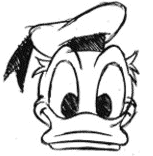 Comics in Italy started to come out as self governing means of expression
just at the beginning of the 30s, even if there were previous notices as
soon as some characters appeared on Il Corriere dei Piccoli, born in 1909,
even though devoid of their typical balloon.
Comics in Italy started to come out as self governing means of expression
just at the beginning of the 30s, even if there were previous notices as
soon as some characters appeared on Il Corriere dei Piccoli, born in 1909,
even though devoid of their typical balloon.So, comics' birth in Italy can be dated around 1932, when Jumbo came out (De Vecchi Publishers
The same publisher afterwards launched Rintintin, where some characters of the American comics found their space, known in Italy as Saltafossi, Maleinpeggio, Pinco e Pallino.
Still in 1932, another editor, Nerbini of Florence, started to
publish the weekly Topolino (Mickey Mouse) which contained, at first,
copies of the famous character by Vitelli e Toppi, but then
the Disney's ![]() authentic dayly strips and Sunday tables.
authentic dayly strips and Sunday tables.
In those years, were edited Il Monello, Tigre Tino and Bombolo (where there were the first Popeye's tables by Segar).
But the most important weekly newspaper for kids (and not only) was L'Avventuroso, which started to be edited in 1934 by Nerbini and contained US characters like Gordon and Agente Segreto X9 (Secret Agent segreto X9) by Alex Raymond, Pat, Radio Pattuglia (Pinky & Molly) by Charlie Schmidt, Cino e Franco (Tim & Spud) by Lyman Young, in a few words the gotha of the comics worldwide.
Another important step was the coming out of the Mondadori Editors ![]() who
published (in 1935) I tre porcellini, which offered a great variety
of English and American characters, as Guido Ventura (Brick Bradford)
by Pitt & Gray. After this, the same editor acquired Topolino from
Nerbini and launched also Il giornale di Cino e Franco.
who
published (in 1935) I tre porcellini, which offered a great variety
of English and American characters, as Guido Ventura (Brick Bradford)
by Pitt & Gray. After this, the same editor acquired Topolino from
Nerbini and launched also Il giornale di Cino e Franco.
Just in this period the critics started to talk about an Italian comics' school which had its way to grow in various directions.
With the end of the war came in Italy chewing gums, Coca Cola, pop-corns and comics in great quantity.
Fifty years passed since Tex Willer came out: the author-editor
Bonelli would suggest with this character a more open-minded and
modern line, not only in western strips but in the whole Italian comics'
history.
Tex, smart and responsible man, always involved in ventures which had
exact historical and geographic references, made a good impression to
millions of readers, both in Italy and in other twelve foreign countries.
But the most important event in that period (which would had been influencing all comics' production, till nowadays) was the birth of characters like Asso di picche, with whom changed the authors' position towards the characters they created: they istinctively sympathize with the outlaws, with the white bandit gone over to the indians or black people.. so that the traditional hero wasn't a real hero but the advocate of a cruel order, which could had been discussed.
Mondadori restarted publishing the Disney band: among the new characters Paperon de' Paperoni (Uncle Scrooge) and Paperino (Donald Duck) had more success. But the news was the Italian production of Disney characters, so autonomous to be translated in all Europe, Asia and Africa and also (in a small part) published in USA.
In those 10 years in Italy came out some new headings which suggested either already famous characters (but in a different editorial dress!) or original ones. In the first category are Flash Gordon, l' Uomo Mascherato (The Phantom) and Mandrake; in the second Sgt. Kirk, Superman (in Italy also called Nembo Kid at first), Diabolik, etc..
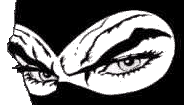 A significant peculiarity of comics production during the sixtees are
"black comics" : the first of the series, Diabolik, was born in
Nov.1962 by Angela and Luciana Giussani. The hero, thanking to his
disguises and his plastic masks, shows almost supernatural powers.
Breaking with the past, Diabolik is not a hero serving the justice but a
criminal who triumphes over law. Only a man, Inspector Ginko, doesn't
stop to persecute him and sometimes pushes him into some difficulties,
giving the story a bit of suspense or it would be boring.
A significant peculiarity of comics production during the sixtees are
"black comics" : the first of the series, Diabolik, was born in
Nov.1962 by Angela and Luciana Giussani. The hero, thanking to his
disguises and his plastic masks, shows almost supernatural powers.
Breaking with the past, Diabolik is not a hero serving the justice but a
criminal who triumphes over law. Only a man, Inspector Ginko, doesn't
stop to persecute him and sometimes pushes him into some difficulties,
giving the story a bit of suspense or it would be boring.
Diabolik is a "crime aristocratic" and not a common criminal, he's a deeply
monogamist, staying always faithful to the beautiful Eva Kant. Diabolik's
success provokes a series of imitations based on erotism and sadism.
Another happy and fruitful news is the birth of Linus in 1965 as a
magazine that represents a great revolution in Italy about tastes on comics:
not only, in fact, Schulz's characters came out but plus started to be
published comics' books, where found their space of course
Charlie Brown, but also Krazy Kat by Herriman,
Li'l Abner by Al Capp, Popeye's old stories by Segar,
Feiffer's characters and new Italian protagonists, such as Valentina by
Crepax, Ghirighiz and Fra' Salmastro by Lunari and so on.
Another cultural merit of Linus is, besides the presence of many good comics,
he publication of articles, historic notes and presentations of authors and
characters, on the whole it's an "open review" for the Italian public.
In a short time, other two publications came out: Tommy and Eureka ('67), which focused as a principal character on Andy Capp, created by Reg Smyte, and obtained an immediate success of public; also, always on this comic magazine, appeared some characters that would have become very famous for Italian public, such as Sturmstruppen, created by Bonvi (Bonvicini), recently died.
Another good magazine in the 60s was Sgt. Kirk, which based its contents on American stories of the 30s (Pat, Pinky and Molly, Steve Canyon and Terry Lee) and on new and old characters created by Italian authors (Sgt. Kirk, Corto Maltese and Asso di Picche).
It's important to underline that on these magazines came out two authors who have influenced the whole comics of our times: Guido Crepax and Hugo Pratt.
Still during the 60s came out new magazines, but all had a short life as Smack, Okay, Off side and editors, at first not related to this genre, published comic books, as Feltrinelli did with Phoebe Zeit Gest.
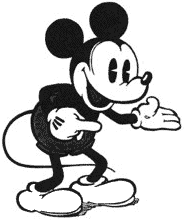 Besides, the traditional editors intensified the publication of the series:
Mondadori Published Asterix, B.C., Il Mago Wiz, the old
stories of Donald Duck and Mickey Mouse; Milano Libri (the same of Linus)
published Dick Tracy, Bristow, etc.
Besides, the traditional editors intensified the publication of the series:
Mondadori Published Asterix, B.C., Il Mago Wiz, the old
stories of Donald Duck and Mickey Mouse; Milano Libri (the same of Linus)
published Dick Tracy, Bristow, etc.
Still, the stories of war imported from Great Britain had a kind of success
(Eroica, SuperEroica) with a fair graphic realization and with some
attention at the human being through the rhetoric of honor, heroism and
patriotism. The sixtees were years of a great editorial fervour.
Also from the US were imported and had a not indifferent success, especially among the youngest readers, the adventures of the characters created by Stan Lee: Captain America, l'Uomo Ragno (Spider Man), Devil, Conan Il Barbaro, I Fantastici Quattro, etc.
An extremely important fact, although culturally independent, is the publication of Dino Buzzati's Poema a fumetti by Mondadori: alternating words and images, an ancient myth (Orfeo and Euridice) lived again through a sensitive Buzzati, who succeeded to translate in the correct way an eternal message as Love.
Although they produced also during the years before the 70s, Pratt, Crepax
and Manara stand out from among the others in the last twenty-five years.
Their fame is very wide not only in Italy but also and especially abroad;
i.e. Pratt publishes first in France, then in Italy and after all in the
rest of the world.
So, the principal characteristic of these years, at least for some authors,
is that they overcome the little spaces of the traditional strip cartoons
stories to launch theirselves into the novel through images and if the
"glamour girls" by Manara can be considered by the critics a work of
art though well connected with comics, the authors symbolize the anxiety and
the will to wander about the world of an entire epoch, the ours.
"Novels through images" we said: an example above all, La Ballata del Mare Salato by Hugo Pratt.
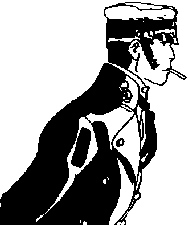 Corto Maltese is an adventurer who represents for Pratt the summa of
many people and many things, especially cultures, readings, cinema and
thoughts and he's the answer to the Anglo-American comics: Corto Maltese's
characteristic is his being Mediterranean, that symbolizes freedom,
adventure, an interesting life. Reader of Thomas More's Utopia, which he
never finish to read entirely really, Corto Maltese conjugates together
utopia and anarchy and unreachable willings.
Corto Maltese is an adventurer who represents for Pratt the summa of
many people and many things, especially cultures, readings, cinema and
thoughts and he's the answer to the Anglo-American comics: Corto Maltese's
characteristic is his being Mediterranean, that symbolizes freedom,
adventure, an interesting life. Reader of Thomas More's Utopia, which he
never finish to read entirely really, Corto Maltese conjugates together
utopia and anarchy and unreachable willings.
Koinsky (also by Pratt), instead, the new hero of the series Gli Scorpioni del Deserto, symbolizes the contrast between the First World War, which still could be said "human" and the Second, finished with the atomic bomb. Koinsky, Polish mercenary, has no ideals, nothing positive and appears as a negative hero.
Another great character created by Pratt is Asso di Picche, forerunner
of many other masked heroes and coming himself from many others appeared
in the US.
As for what concerns the graphic realization Pratt's cartoons are neat,
with a powerful skill of suggestion that made them very famous all over the
world.
After Valentina and Corto Maltese, another hero of our times is
Cipputi by Altan, character born by chance. At the end of his
evolution, the working class feels this character as part of itself.
Altan created another unusual figure: La Pimpa, the strange dog with
red pois, born to entertain her daughter and that recalls childrens' way to
draw.
New characters were created also by Bonelli: among them Zagor, Dylan Dog,
Martin Mystere, etc.
Other newspapers entirely dedicated to comics were born: among the recent
ones Il Grifo and Corto Maltese (which ends in 1993), Il Mago,
edited by Mondadori at the beginning of the 70s, which launched the
Eternauta, destined to wander through the centuries. But
Il Mago had a short life.
If the sixtees announced better times for the traditional comics, confirmed in the following period, today we must distinguish between high quality (but low circulation), medium quality (high circulation) and low quality for whom there's no future. There's also an amateurish production, destined to collectors, whose editions are limited.
A serious editorial crisis, not only for comics, is outlined against the horizon. A recent phenomenon, which in some way makes up for the closing of specialized magazines, is the birth of the didactic comics, with a high cultural level. An example of this type of comics is La Storia d'Italia a fumetti by Enzo Biagi, published by Mondadori, in which the author succeeds to tell the great historical events with a new language.
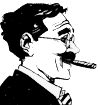 Today Dylan Dog by Tiziano Sclavi, edited by Bonelli, dominates the scene
of Italian comics.
Today Dylan Dog by Tiziano Sclavi, edited by Bonelli, dominates the scene
of Italian comics.
Dylan Dog was born with a peculiar strong cinematographic component,
conjugating two media, which, though different as for the language they use,
had in common the image's suggestion.
Dylan Dog is perhaps also the only hero who has a big success among the
women; his long face, always a bit sad, takes inspiration directly from the
actor Rupert Everett, even if his name reminds the singer Bob Dylan.
Where other heroes have a strong character, this one is also able to ask
himself questions and suffer, especially for love, because Dylan in his
stories meets many women and with the most part he starts a relationship,
though if always finishes in a tragic way, leaving something in the
character of the hero.
The characters are spontaneous and their credibility is probably the
secret of Dylan Dog's success, besides a young and modern language.
![]() Tex Willer (12K)
Tex Willer (12K) ![]()
![]() Sturmtruppen (28K)
Sturmtruppen (28K) ![]()
![]() Peanuts (13K)
Peanuts (13K) ![]()
![]() Superman (25K)
Superman (25K) ![]()
![]() Diabolik & Eva (15K)
Diabolik & Eva (15K) ![]()
![]() Dylan Dog (18K)
Dylan Dog (18K) ![]()
![]() Popeye (15K)
Popeye (15K) ![]()
![]() An animated story of Flash Gordon (84K)
An animated story of Flash Gordon (84K) ![]()
Go to the top of the page